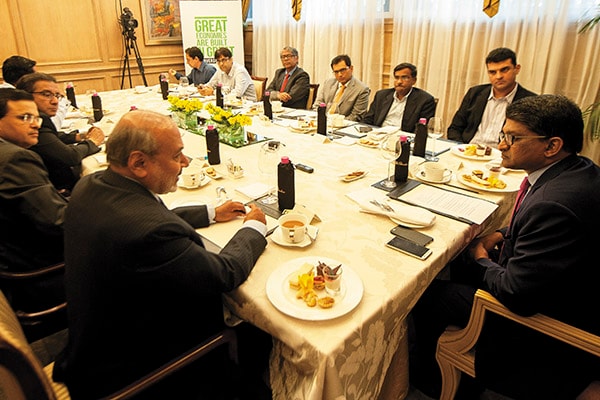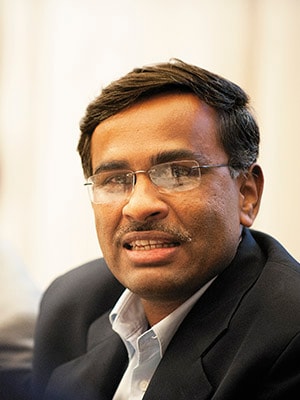
Despite short-term pain, India Inc stays future positive
Nagging concerns notwithstanding, experts believe that the government is on the right track with its economic policies
Euphoria has made way for cautious optimism. A year after the Narendra Modi-led government came to power, there are now concerns about whether it will be able to deliver on the promises it has made.
As part of the second season of the Forbes India CEO Dialogues: The Leadership Agenda, Siddharth Roy Kapur, managing director of Disney India; Vikram Limaye, managing director and CEO of IDFC; Habil Khorakiwala, Wockhardt’s founder-chairman and group CEO; Sanjay Shah, co-country head & co-head of Indian equity business, Morgan Stanley and Sunil Kaushal, CEO for India & South Asia, Standard Chartered Bank, spoke about the issues dogging the government and their expectations for the near future.
A few takeaways: They believe there could be short-term challenges in the form of an incremental rise in non-performing assets (NPAs) in the financial sector. To ensure improvement in the ease of doing business, India will need to make it a state-led initiative. Also, infrastructure spending and recapitalisation of state-run banks will have to be stepped up. The government will need to engage with business houses too.
Excerpts from the discussion moderated by Senthil Chengalvarayan, president and editorial director, TV18 Business Newsroom:
Senthil Chengalvarayan: Vikram, as a banker-to-be [IDFC will start banking operations by October], is the worst behind us or is IDFC becoming a bank at a terrible time?
Vikram Limaye: We have a handle on the size of the [non-performing assets] problem, but it’s very large. It is yet to hit the balance sheets of financial services firms. And therefore, I think the worst is not behind us. In the financial services sector, restructured assets cannot get worse, as post-March 31, it was not permitted by the Reserve Bank of India. There may be a migration of restructured assets to NPAs and hence there could be incremental NPAs.
In the last two years, the investment cycle has slowed and some industries are in trouble due to the economic slowdown. Small and medium-sized companies continue to face problems as they are not getting enough credit or support. There is uncertainty globally due to which export-related industries are facing problems. There are headwinds for sure. I don’t think the entire problem has been recognised in terms of losses that the financial sector has borne, but the size of the problem will not grow materially.
Chengalvarayan: India has made the right noises [about growth] but has the ease of doing business improved in the past year? What more does the government need to do?
Habil Khorakiwala: There has been no significant change in ground reality, but I am pleasantly surprised to know that Punjab has created a one-window clearance for industries (at the IAS/secretary level), which has been given powers for 8-10 clearances. We need structural changes like these. The government, in 2014, was de-risking major changes. It did not want to take the political risk of big changes; so what we see are incremental improvements in some areas and policy announcements in the defence, railways and power sectors.
Chengalvarayan: Does the government not want to take tough political decisions as it does not have the mandate in the Rajya Sabha? Or is it that it does not want to take decisions, which can be pushed through without making policy changes, as it is worried about the political fallout?
Khorakiwala: The government wants to bring about changes, but there is too much centralisation of decision-making and, therefore, too much of micro-management. One can then lose the bigger picture. This government is becoming too politically sensitive to do things. It should have taken bold decisions in some areas by now.
Chengalvarayan: Sanjay, you have been bullish about the markets even while some brokerage firms have cut index targets. Does your bullishness rest on outperformance or on the potential?
Sanjay Shah: We are quite positive about India. Earlier, [policy in] India was two steps forward and one step back; now it is two steps forward and half a step back. We have made progress in cutting out crony capitalism and focusing on social inclusion. The government’s use of technology is also impressive; it is helping in issuing clearances and licences. India is growing at 7.3 percent (according to the new data series) annually and this can improve to 7.9 percent in the next fiscal, driven by infrastructure and public sector spending. In terms of India’s fiscal health, we have never been better. Forex reserves are at an all-time high, inflation is at a multi-year low; foreign direct investment continues to rise; both fiscal and current account deficits are much better contained than in the past.
Chengalvarayan: Siddharth, where do you stand, vis-à-vis last year?
Siddharth Roy Kapur: Pretty much where everybody else was when the government took charge: Cautiously optimistic. The government is quite focussed on the ease of doing business, but its implementation at each level will take time. The perception of the country has changed, for the better, overseas in the past year. It has aided Indian companies and local branches of global organisations in improving sentiment for investments into India.
Also, the government recognises the use of soft power. The media and entertainment (M&E) sector contributes only 0.5 percent to the country’s GDP, but the contribution it can make in terms of perception and driving the India story is significant. I hope that creativity and commercial potential in the M&E sector is leveraged and the powers-that-be recognise this, the way China did.
Chengalvarayan: How should the government market India for investments?
Roy Kapur: I think it is doing a decent job. When I speak about soft power, look at China... despite all its protectionism, China had 7,000-8,000 screens in 2009 compared with 9,000-10,000 in India. Today, it has 36,000 screens while in India, the number still languishes at around 8,000 to 10,000. China has been able to incentivise the exhibition sector with tax incentives and subsidies. It is the second-largest theatrical market after the US. India, which loves its entertainment and leisure, must do the same.
Chengalvarayan: Sunil, credit growth is at a multi-year low. The threat of NPAs looms, balance sheets of banks are not good. When do you see credit growth picking up?
Sunil Kaushal: Credit growth in 2014 came from retail, agriculture and the SME sector. Broadly, there are two camps: One camp kept their powder dry [balance sheets were strong and not too leveraged]. These are looking good and are optimistic of a turnaround. But there is a long middle and much longer tail of companies that are highly leveraged and they will not grow in a hurry. They need equity to come in.
Chengalvarayan: How long will this take? I remember discussing the same issue at Wharton School in 2009.
Kaushal: The successful restructuring of a company takes three years. The middle and tail companies will not invest in a hurry. So some companies will do well, others will struggle. We are a capital-deficient country and we need to attract domestic capital and foreign direct investment. Also, our banks will have to be adequately capitalised for them to be in a position to leverage and fuel this growth. By 2019, India needs $40 billion of fresh capital to meet global Basel III norms. The allocation by the government in the previous budget for [public sector] bank capitalisation was just Rs 7,900 crore ($1.2 billion). The capital gap is massive… we need to fix the source of funding.
Chengalvarayan: Vikram, how much can the long tail lash and wreak havoc? Limaye: It is a long tail but the problem is that some of our largest business houses are also under stress. We cannot be long on India and short on infrastructure. We cannot grow at 8-9 percent in a sustainable way without infrastructure growth. We are counting on a system which is 60-odd years old and is not structured for where the country needs to be for the next 30-40 years.
Chengalvarayan: The government is calling 2015 as the bulk drug year. Is it barking up the wrong tree?
Khorakiwala: Yes. We get carried away by China [and its story]. India buys intermediates from China which is a low-value creation activity. It then develops the active pharmaceutical ingredients, makes formulations and sells them at much higher valuations. There’s nothing wrong, but some bulk drug companies have concerns.
Limaye: What I worry about is the politicisation of every initiative that seems to benefit the private sector and labelling the government as being anti-poor. We don’t want the decibel levels to go up.
Chengalvarayan: Has the government lived up to its promise?
Shah: We forget how bad things were in the past. The government has tried to focus on finding the right people and bureaucrats. The prime minister is trying to sort out our relationship with neighbouring countries and other nations.
Rather than going for short-term solutions, the government is thinking long term. It could have recapitalised state-run banks. Was it the right thing to do? There are issues like talent pool, operations and governance concerns which banks face. Unless you address these three factors, it would be like putting good money after bad.
Limaye: The talent pool in PSU banks is very good, but they joined the banking system 30 years ago. The leaders of tomorrow are the ones who joined the system 15 years ago. The future of PSU banks—from a talent and management perspective—is not going to get better; it will get worse. They will lose their share to the private sector. If your hands and legs are tied and you are asked to run, it is not easy.
Chengalvarayan: Are we cautiously optimistic as we realise that the reality is different or because there are global concerns?
Limaye: I am optimistic about the medium to long term as we have huge domestic investment potential. We are not as dependent on the external environment from a growth perspective (though from a capital perspective, we are). I also believe that some structural changes, which the government is focussed on, will yield results over the long term.
Shah: We are most excited about domestic savings returning to the capital markets. After years of negative real rates, we are now getting to a stage of positive real rates. The momentum will shift from physical assets to financial savings.
Khorakiwala: I feel that at the end of the Modi government’s five-year tenure, India should be growing at around 9 percent.
Roy Kapur: I am cautiously optimistic about the short term and very optimistic about the long term. There will be short-term pain. But after that, things should look good.
(This story appears in the 30 November, -0001 issue of Forbes India. To visit our Archives, click here.)








